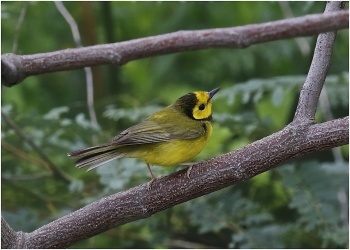- Setophaga citrina
Wilsonia citrina
Identification

Photo by Jones Stanley Jones
Lafitte’s Cove Nature Preserve, Lafitte’s Cove Subdivision, Galveston, Texas, USA, April 2018
5 1/2" (14 cm).
Olive above, yellow below. Male has yellow face, black hood and black throat.
Female lacks hood or has only a trace of it. Both sexes have white tail spots.
Similar Species
See Bachman's Warbler.
Distribution
Eastern United States from central New York and Connecticut south to northern Florida west to eastern Texas north to south Missouri, Illinois and Indiana; scattered populations north of western part of range.
Breeds from Iowa, Michigan, and southern New England south to Gulf Coast and northern Florida. Winters from Mexico south to northern South America.
Accidental vagrant to Great Britain (2 records).
Taxonomy
This is a monotypic species[1].
Formerly placed in genus Wilsonia.
Habitat
Mature, moist forests with luxuriant undergrowth, especially in ravines; also in wooded swamps.
Behaviour
Action
Both adults have conspicuous white tail spots, which they flash while moving about.
Diet
This species usually ranges at a low level, rarely 10 feet (3 meters) above the ground. The also feed by hover-gleaning; also gleans in the understorey. Like most members of the family, it is adept at fly-catching.
Their main diet consists of insects and spiders.
Breeding
Nesting: 3 or 4 creamy-white, brown-spotted eggs in a grass-lined nest of dead leaves and plant fibers, placed low in a small tree or shrub.
Vocalisation
A loud, penetrating, and very melodious song.
Clear, ringing tawee-tawee-tawee-tee-o.
Song
Recording © by NJLarsen, Carolina Sandhills NWR, South Carolina,USA, 29 May 2023. The two times the warbler vocalized are about 20 seconds apart. Background species in this recording include Northern Cardinal and Great Crested Flycatcher.
References
- Clements, J. F., T. S. Schulenberg, M. J. Iliff, D. Roberson, T. A. Fredericks, B. L. Sullivan, and C. L. Wood. 2017. The eBird/Clements checklist of birds of the world: v2017, with updates to August 2017. Downloaded from http://www.birds.cornell.edu/clementschecklist/download/
- Avibase
- Handbook of the Birds of the World Alive (retrieved August 2016)
- BF Member observations
Recommended Citation
- BirdForum Opus contributors. (2024) Hooded Warbler. In: BirdForum, the forum for wild birds and birding. Retrieved 6 October 2024 from https://www.birdforum.net/opus/Hooded_Warbler
External Links
GSearch checked for 2020 platform.1





